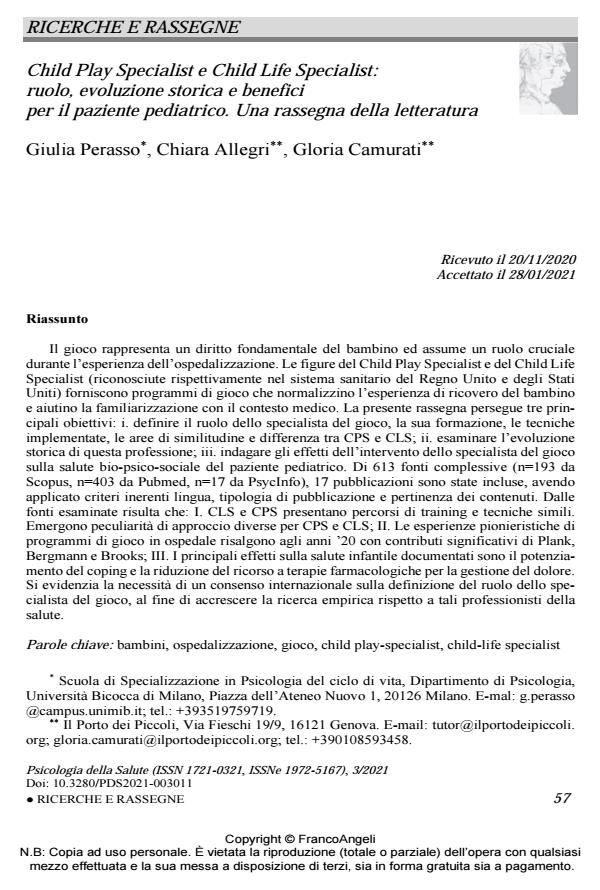Child Play Specialist e Child Life Specialist: ruolo, evoluzione storica e benefici per il paziente pediatrico. Una rassegna della letteratura
Titolo Rivista PSICOLOGIA DELLA SALUTE
Autori/Curatori Giulia Perasso, Chiara Allegri, Gloria Camurati
Anno di pubblicazione 2021 Fascicolo 2021/3
Lingua Italiano Numero pagine 25 P. 57-81 Dimensione file 331 KB
DOI 10.3280/PDS2021-003011
Il DOI è il codice a barre della proprietà intellettuale: per saperne di più
clicca qui
Qui sotto puoi vedere in anteprima la prima pagina di questo articolo.
Se questo articolo ti interessa, lo puoi acquistare (e scaricare in formato pdf) seguendo le facili indicazioni per acquistare il download credit. Acquista Download Credits per scaricare questo Articolo in formato PDF

FrancoAngeli è membro della Publishers International Linking Association, Inc (PILA)associazione indipendente e non profit per facilitare (attraverso i servizi tecnologici implementati da CrossRef.org) l’accesso degli studiosi ai contenuti digitali nelle pubblicazioni professionali e scientifiche
Il gioco rappresenta un diritto fondamentale del bambino ed assume un ruolo cruciale du-rante l’esperienza dell’ospedalizzazione. Le figure del Child Play Specialist e del Child Life Specialist (riconosciute rispettivamente nel sistema sanitario del Regno Unito e degli Stati Uni-ti) forniscono programmi di gioco che normalizzino l’esperienza di ricovero del bambino e aiutino la familiarizzazione con il contesto medico. La presente rassegna persegue tre principali obiettivi: i. definire il ruolo dello specialista del gioco, la sua formazione, le tecniche implemen-tate, le aree di similitudine e differenza tra CPS e CLS; ii. esaminare l’evoluzione storica di questa professione; iii. indagare gli effetti dell’intervento dello specialista del gioco sulla salute bio-psico-sociale del paziente pediatrico. Di 613 fonti complessive (n=193 da Scopus, n=403 da Pubmed, n=17 da PsycInfo), 17 pubblicazioni sono state incluse, avendo applicato criteri inerenti lingua, tipologia di pubblicazione e pertinenza dei contenuti. Dalle fonti esaminate ri-sulta che: I. CLS e CPS presentano percorsi di training e tecniche simili. Emergono peculiarità di approccio diverse per CPS e CLS; II. Le esperienze pionieristiche di programmi di gioco in ospedale risalgono agli anni ’20 con contributi significativi di Plank, Bergmann e Brooks; III. I principali effetti sulla salute infantile documentati sono il potenziamento del coping e la ridu-zione del ricorso a terapie farmacologiche per la gestione del dolore. Si evidenzia la necessità di un consenso internazionale sulla definizione del ruolo dello specialista del gioco, al fine di accrescere la ricerca empirica rispetto a tali professionisti della salute.
Parole chiave:bambini, ospedalizzazione, gioco, child play-specialist, child-life specialist
- Handbook of Research on Play Specialism Strategies to Prevent Pediatric Hospitalization Trauma Arianna Bentenuto, Silvia Perzolli, Simona de Falco, Paola Venuti, pp.240 (ISBN:9781668450680)
- Handbook of Research on Play Specialism Strategies to Prevent Pediatric Hospitalization Trauma Giulia Perasso, pp.306 (ISBN:9781668450680)
Giulia Perasso, Chiara Allegri, Gloria Camurati, Child Play Specialist e Child Life Specialist: ruolo, evoluzione storica e benefici per il paziente pediatrico. Una rassegna della letteratura in "PSICOLOGIA DELLA SALUTE" 3/2021, pp 57-81, DOI: 10.3280/PDS2021-003011